Retrieval of Aerosol Optical Thickness with Custom Aerosol Model Using SKYNET Data over the Chiba Area
Abstract
:1. Introduction
2. Research Area and Datasets
2.1. Research Area
2.2. SKYNET-Based Observation
2.3. Himawari-8 AHI
2.4. Landsat-8 OLI
3. Materials and Methods
3.1. Custom Aerosol Model
3.2. Radiative Transfer Handled by 6S
3.3. Process of AOT Retrieval
4. Results
4.1. Look Up Tables
4.2. Reference of Surface Albedo
4.3. Spatiotemporal Analysis and Characteristics of AOT Distribution
5. Discussion
5.1. Accuracy Validation
5.2. A Case Analysis of Landsat-8 OLI
6. Conclusions
- The AOT values in the Chiba area tend to be large (about 0.3) in spring due to the influence of yellow sand and air pollutants flying from the continent, and small (0.2 or less) in winter, matching the ground observation values. In this way, it was found that the optical characteristics of the surface albedo are considered to be an accurate reference to retrieve AOTs.
- The sky-radiometer data observed at CEReS is used to constraint the aerosol model through the wavelength dependence of AOTs, and we assumed custom aerosol model can be applied to the whole Kanto area based on surface albedo under clear-sky conditions. Additionally, the reference of surface albedo generated from clear-sky conditions can be employed to retrieve the spatial distribution of AOTs not only on clear but also relatively turbid days.
- The method proposed in this study can be used to establish a good reference for the analysis of various visible satellite images such as Himawari-8/AHI or Landsat-8/OLI to evaluate the AOT distribution over the Chiba area and potentially over similar urban areas.
- The versatility and reliability of the SKYNET-based measurement have provided information valuable for radiation studies, including the validation of satellite data. The validation results indicate that the proposed method can effectively generate reliable AOT distribution results.
Author Contributions
Funding
Institutional Review Board Statement
Informed Consent Statement
Data Availability Statement
Acknowledgments
Conflicts of Interest
References
- Monks, P.S.; Granier, C.; Fuzzi, S.; Stohl, A.; Williams, M.L.; Akimoto, H.; Amann, M.; Baklanov, A.; Baltensperger, U.; Bey, I.; et al. Atmospheric composition change–global and regional air quality. Atmos. Environ. 2009, 43, 5268–5350. [Google Scholar] [CrossRef] [Green Version]
- Kuze, H. Multi-wavelength and multi-direction remote sensing of atmospheric aerosols and clouds. Remote. Sens.-Appl. 2012, 279–294. [Google Scholar] [CrossRef] [Green Version]
- Gao, J.H.; Woodward, A.; Vardoulakis, S.; Kovats, S.; Wilkinson, P.; Li, L.P.; Xu, L.; Li, J.; Yang, J.; Li, J.; et al. Haze, public health and mitigation measures in China: A review of the current evidence for further policy response. Sci. Total Environ. 2017, 578, 148–157. [Google Scholar] [CrossRef]
- Bach, H.; Verhoef, W.; Schneider, K. Coupling remote sensing observation models and a growth model for improved retrieval of (geo)-biophysical information from optical remote sensing data. In Remote Sensing for Agriculture, Ecosystems, and Hydrology II; International Society for Optics and Photonics: Bellingham, WA, USA, 2001. [Google Scholar] [CrossRef]
- Letu, H.; Yang, K.; Nakajima, T.Y.; Ishimoto, H.; Nagao, T.M.; Riedi, J.; Baran, A.J.; Ma, R.; Wang, T.; Shang, H.; et al. High-resolution retrieval of cloud microphysical properties and surface solar radiation using Himawari-8/AHI next-generation geostationary satellite. Remote. Sens. Environ. 2020, 239, 111583. [Google Scholar] [CrossRef]
- Vermote, E.; Justice, C.; Csiszar, I. Early evaluation of the VIIRS calibration, cloud mask and surface reflectance Earth data records. Remote Sens. Environ. 2014, 148, 134–145. [Google Scholar] [CrossRef] [Green Version]
- Gao, B.C.; Montes, M.J.; Davis, C.O.; Goetz, A.F.H. Atmospheric correction algorithms for hyperspectral remote sensing data of land and ocean. Remote Sens. Environ. 2009, 113, S17–S24. [Google Scholar] [CrossRef]
- Vermote, E.F.; Tanre, D.; Deuze, J.L.; Herman, M.; Morcette, J.-J. Second Simulation of the Satellite Signal in the Solar Spectrum, 6S: An overview. IEEE Trans. Geosci. Remote Sens. 1997, 35, 675–686. [Google Scholar] [CrossRef] [Green Version]
- Guanter, L. On the application of the MODTRAN4 atmospheric radiative transfer code to optical remote sensing. Int. J. Remote. Sens. 2009, 30, 1407–1424. [Google Scholar] [CrossRef]
- Manago, N.; Kuze, H. Seasonal variation of tropospheric aerosol properties by direct and scattered solar radiation spectroscopy. J. Quant. Spectrosc. Radiat. Transf. 2011, 112, 285–291. [Google Scholar] [CrossRef]
- She, L.; Xue, Y.; Yang, X.H.; Leys, J.; Guang, J.; Che, Y.H.; Fan, C.; Xie, Y.Q.; Li, Y. Joint retrieval of aerosol optical depth and surface reflectance over land using geostationary satellite data. IEEE Trans. Geosci. Remote Sens. 2018, 57, 1489–1501. [Google Scholar] [CrossRef]
- Irie, H.; Hoque, H.M.S.; Damiani, A.; Okamoto, H.; Fatmi, A.M.; Khatri, P.; Takamura, T.; Jarupongsakul, T. Simultaneous observations by sky radiometer and MAX-DOAS for characterization of biomass burning plumes in central Thailand in January–April 2016. Atmos. Meas. Tech. 2019, 12, 599–606. [Google Scholar] [CrossRef] [Green Version]
- Nakajima, T.; Campanelli, M.; Che, H.; Estellés, V.; Irie, H.; Kim, S.W.; Kim, J.; Liu, D.; Nishizawa, T.; Pandithurai, G.; et al. An overview of and issues with sky radiometer technology and SKYNET. Atmos. Meas. Tech. 2020, 13, 4195–4218. [Google Scholar] [CrossRef]
- Mukai, S.; Sano, I.; Holben, B.N. Aerosol properties over Japan determined by Sun/sky photometry. Water Air Soil Pollut. Focus 2005, 5, 133–143. [Google Scholar] [CrossRef]
- Uchiyama, A. Method to retrieve single scattering properties of aerosols using multi-wavelength scattering and absorption coefficient data measured by integrating nephelometer and absorption photometer. J. Meteorol. Soc. Jpn. Ser. II 2014, 92, 71–91. [Google Scholar] [CrossRef] [Green Version]
- Hoque, H.M.S.; Irie, H.; Damiani, A. First MAX-DOAS Observations of Formaldehyde and Glyoxal in Phimai, Thailand. J. Geophys. Res. Atmos. 2018, 123, 9957–9975. [Google Scholar] [CrossRef]
- Damiani, A.; Irie, H.; Horio, T.; Takamura, T.; Khatri, P.; Takenaka, H.; Nagao, T.; Nakajima, T.Y.; Cordero, R.R. Evaluation of Himawari-8 surface downwelling solar radiation by ground-based measurements. Atmos. Meas. Tech. 2018, 11, 2501–2521. [Google Scholar] [CrossRef] [Green Version]
- Sano, I.; Yamano, M.; Takamura, T.; Nakajima, T.; Holben, B. Calibration and validation of retrieved aerosol properties based on AERONET and SKYNET. Adv. Space Res. 2003, 32, 2159–2164. [Google Scholar] [CrossRef]
- Torres, O.; Bhartia, P.K.; Herman, J.R.; Sinyuk, A.; Ginoux, P.; Holben, B. A Long-Term Record of Aerosol Optical Depth from TOMS Observations and Comparison to AERONET Measurements. J. Atmos. Sci. 2002, 59, 398–413. [Google Scholar] [CrossRef] [Green Version]
- Khatri, P.; Takamura, T.; Nakajima, T.; Estellés, V.; Irie, H.; Kuze, H.; Campanelli, M.; Sinyuk, A.; Lee, S.-M.; Sohn, B.J.; et al. Factors for inconsistent aerosol single scattering albedo between SKYNET and AERONET. J. Geophys. Res. Atmos. 2016, 121, 1859–1877. [Google Scholar] [CrossRef] [Green Version]
- Wang, L.; Cai, K.; Si, Y.; Yu, C.; Zheng, H.; Li, S. Evaluation of Himawari-8 version 2.0 aerosol products against AERONET ground-based measurements over central and northern China. Atmospheric Environment. 2020, 224, 117357. [Google Scholar] [CrossRef]
- Irie, H.; Horio, T.; Damiani, A.; Nakajima, T.Y.; Takenaka, H.; Kikuchi, M.; Khatri, P.; Yumimoto, K. Importance of Himawari-8 aerosol products for energy management system. Earozoru Kenkyu 2017, 32, 95–100. [Google Scholar] [CrossRef]
- Li, Z.B.; Roy, D.P.; Zhang, H.K.; Vermote, E.F.; Huang, H.Y. Evaluation of Landsat-8 and Sentinel-2A aerosol optical depth retrievals across Chinese cities and implications for medium spatial resolution urban aerosol monitoring. Remote Sens. 2019, 11, 122. [Google Scholar] [CrossRef] [Green Version]
- Choi, Y.; Ghim, Y.S. Variations in major aerosol components from long-term measurement of columnar aerosol optical properties at a SKYNET site downwind of Seoul, Korea. Atmos. Environ. 2021, 245, 117991. [Google Scholar] [CrossRef]
- Zhong, B.; Wu, S.L.; Yang, A.X.; Ao, K.; Wu, J.H.; Wu, J.J.; Gong, X.S.; Wang, H.B.; Liu, Q.H. An Atmospheric Correction Method over Bright and Stable Surfaces for Moderate to High Spatial-Resolution Optical Remotely Sensed Imagery. Remote Sens. 2020, 12, 733. [Google Scholar] [CrossRef] [Green Version]
- Wilson, R.T.; Milton, E.J.; Nield, J.M. Are visibility-derived AOT estimates suitable for parameterizing satellite data atmospheric correction algorithms. Int. J. Remote. Sens. 2015, 36, 1675–1688. [Google Scholar] [CrossRef] [Green Version]
- Hadjimitsis, D.G. Aerosol optical thickness (AOT) retrieval over land using satellite image-based algorithm. Air Qual. Atmos. Health 2009, 2, 89–97. [Google Scholar] [CrossRef] [Green Version]
- Kumharn, W.; Janjai, S.; Irie, H.; Pilahome, O. Aerosol size distribution using Thailand ground-based instruments and climate variables. Theor. Appl. Climatol. 2020, 142, 599–611. [Google Scholar] [CrossRef]
- Lagrosas, N.; Bagtasa, G.; Manago, N.; Kuze, H. Influence of ambient relative humidity on seasonal trends of the scattering enhancement factor for aerosols in Chiba, Japan. Aerosol Air Qual. Res. 2019, 19, 1856–1871. [Google Scholar] [CrossRef] [Green Version]
- Li, Z.Q.; Xu, H.; Li, K.T.; Li, D.H.; Xie, Y.S.; Li, L.; Zhang, Y.; Gu, X.F.; Zhao, W.; Tian, Q.J.; et al. Comprehensive study of optical, physical, chemical, and radiative properties of total columnar atmospheric aerosols over China: An overview of Sun-Sky Radiometer Observation Network (SONET) measurements. Bull. Am. Meteorol. Soc. 2018, 99, 739–755. [Google Scholar] [CrossRef]
- Hashimoto, M.; Nakajima, T.; Dubovik, O.; Campanelli, M.; Che, H.; Khatri, P.; Takamura, T.; Pandithurai, G. Development of a new data-processing method for SKYNET sky radiometer observations. Atmos. Meas. Tech. 2012, 5, 2723–2737. [Google Scholar] [CrossRef] [Green Version]
- Uchiyama, A.; Matsunaga, T.; Yamazaki, A. The instrument constant of sky radiometers (POM-02), Part II: Solid view angle 2. Atmos. Meas. Tech. 2018, 11, 5389–5402. [Google Scholar] [CrossRef] [Green Version]
- Hoque, H.M.S.; Irie, H.; Damiani, A.; Momoi, M. Primary Evaluation of the GCOM-C Aerosol Products at 380 nm Using Ground-Based Sky Radiometer Observations. Remote Sens. 2020, 12, 2661. [Google Scholar] [CrossRef]
- Momoi, M.; Kudo, R.; Aoki, K.; Mori, T.; Miura, K.; Okamoto, H.; Irie, H.; Shoji, Y.; Uchiyama, A.; Ijima, O.; et al. Development of on-site self-calibration and retrieval methods for sky-radiometer observations of precipitable water vapor. Atmos. Meas. Tech. 2020, 13, 2635–2658. [Google Scholar] [CrossRef]
- Irie, H.; Kanaya, Y.; Akimoto, H.; Iwabuchi, H.; Shimizu, A.; Aoki, K. First retrieval of tropospheric aerosol profiles using MAX-DOAS and comparison with lidar and sky radiometer measurements. Atmos. Chem. Phys. 2008, 8, 341–350. [Google Scholar] [CrossRef] [Green Version]
- Japan Meteorological Agency. Himawari-8/9 Himawari Standard Data User’s Guide (ver.1.2). 2015. Available online: http://www.data.jma.go.jp/mscweb/en/himawari89/space_segment/hsd_sample/HS_D_users_guide_en_v12.pdf (accessed on 1 July 2021).
- Daisaku, U. Aerosol Optical Depth product derived from Himawari-8 data for Asian dust monitoring. Meteorol. Satell. Cent. Tech. Note 2016, 16, 56–63. [Google Scholar]
- Okuyama, A.; Takahashi, M.; Date, K.; Hosaka, K.; Murata, H.; Tabata, T.; Yoshino, R. Validation of Himawari-8/AHI radiometric calibration based on two years of in-orbit data. J. Meteorol. Soc. Japan. Ser. II 2018, 96, 91–109. [Google Scholar] [CrossRef] [Green Version]
- Letu, H.; Nagao, T.M.; Nakajima, T.Y.; Riedi, J.; Ishimoto, H.; Baran, A.J.; Shang, H.; Sekiguchi, M.; Kikuchi, M. Ice cloud properties from Himawari-8/AHI next- generation geostationary satellite: Capability of the AHI to monitor the DC cloud generation process. IEEE Trans. Geosci. Remote Sens. 2018, 57, 1–11. [Google Scholar] [CrossRef]
- Miura, T.; Nagai, S.; Takeuchi, M.; Ichii, K.; Yoshioka, H. Improved Characterisation of Vegetation and Land Surface Seasonal Dynamics in Central Japan with Himawari-8 Hypertemporal Data. Sci. Rep. 2019, 9, 1–12. [Google Scholar] [CrossRef] [Green Version]
- Yamamoto, Y.; Ichii, K.; Higuchi, A.; Takenaka, H. Geolocation Accuracy Assessment of Himawari-8/AHI Imagery for Application to Terrestrial Monitoring. Remote Sens. 2020, 12, 1372. [Google Scholar] [CrossRef]
- Jang, E.; Kang, Y.; Im, J.; Lee, D.W.; Yoon, J.; Kim, S.K. Detection and monitoring of forest fires using Himawari-8 geostationary satellite data in South Korea. Remote Sens. 2019, 11, 271. [Google Scholar] [CrossRef] [Green Version]
- Yumimoto, K.; Nagao, T.M.; Kikuchi, M.; Sekiyama, T.T.; Murakami, H.; Tanaka, T.Y.; Ogi, A.; Irie, H.; Khatri, P.; Okumura, H.; et al. Aerosol data assimilation using data from Himawari-8, a next-generation geostationary meteorological satellite. Geophys. Res. Lett. 2016, 43, 5886–5894. [Google Scholar] [CrossRef]
- Vermote, E.; Justice, C.; Claverie, M.; Franch, B. Preliminary analysis of the performance of the Landsat 8/OLI land surface reflectance product. Remote Sens. Environ. 2016, 185, 46–56. [Google Scholar] [CrossRef]
- Fukagawa, S.; Kuze, H.; Bagtasa, G.; Naito, S.; Yabuki, M.; Takamura, T.; Takeuchi, N. Characterization of seasonal variation of tropospheric aerosols in Chiba, Japan. Atmos. Environ. 2006, 40, 2160–2168. [Google Scholar] [CrossRef]
- Kotchenova, S.Y.; Vermote, E.F.; Matarrese, R.; Klemm, F.J. Validation of a vector version of the 6S radiative transfer code for atmospheric correction of satellite data. Part I: Path radiance. Appl. Opt. 2006, 45, 6762–6774. [Google Scholar] [CrossRef] [Green Version]
- Aminuddin, J.; Okude, S.I.; Lagrosas, N.; Manago, N.; Kuze, H. Real time derivation of atmospheric aerosol optical properties by concurrent measurements of optical and sampling instruments. Open J. Air Pollut. 2018, 7, 140. [Google Scholar] [CrossRef] [Green Version]
- Haifeng, H.; Jianrong, K.; Xiaoke, Z.; Kaiyuan, D. Atmospheric correction of SPOT satellite images based on radiation transfer model. In Proceedings of the 2010 International Conference on Computer Application and System Modeling (ICCASM 2010), Taiyuan, China, 22–24 October 2010; pp. V5-188–V5-191. [Google Scholar] [CrossRef]
- Schillings, C.; Mannstein, H.; Meyer, R. Operational method for deriving high resolution direct normal irradiance from satellite data. Sol. Energy 2004, 76, 475–484. [Google Scholar] [CrossRef]
- Kaufman, Y.J.; Tanré, D.; Remer, L.A.; Vermote, E.F.; Chu, A.; Holben, B.N. Operational remote sensing of tropospheric aerosol over land from EOS moderate resolution imaging spectroradiometer. J. Geophys. Res. Atmos. 1997, 102, 17051–17067. [Google Scholar] [CrossRef]
- Zhang, Q.; Quan, J.N.; Tie, X.X.; Li, X.; Liu, Q.; Gao, Y.; Zhao, D.L. Effects of meteorology and secondary particle formation on visibility during heavy haze events in Beijing, China. Sci. Total Environ. 2015, 502, 578–584. [Google Scholar] [CrossRef]
- Ångström, A. The parameters of atmospheric turbidity. Tellus 1964, 16, 64–75. [Google Scholar] [CrossRef] [Green Version]
- Kaufman, Y.J.; Tanré, D.; Gordon, H.R.; Nakajima, T.; Lenoble, J.; Frouin, R.; Grassl, H.; Herman, B.M.; King, M.D.; Teillet, P.M. Passive remote sensing of tropospheric aerosol and atmospheric correction for the aerosol effect. J. Geophys. Res. Atmos. 1997, 102, 16815–16830. [Google Scholar] [CrossRef] [Green Version]
- Jin, Y.; Hao, Z.; Chen, J.; He, D.; Tian, Q.; Mao, Z.; Pan, D. Retrieval of Urban Aerosol Optical Depth from Landsat 8 OLI in Nanjing, China. Remote Sens. 2021, 13, 415. [Google Scholar] [CrossRef]
- Sun, L.; Wei, J.; Bilal, M.; Tian, X.; Jia, C.; Guo, Y.; Mi, X. Aerosol optical depth retrieval over bright areas using Landsat 8 OLI images. Remote Sens. 2016, 8, 23. [Google Scholar] [CrossRef] [Green Version]
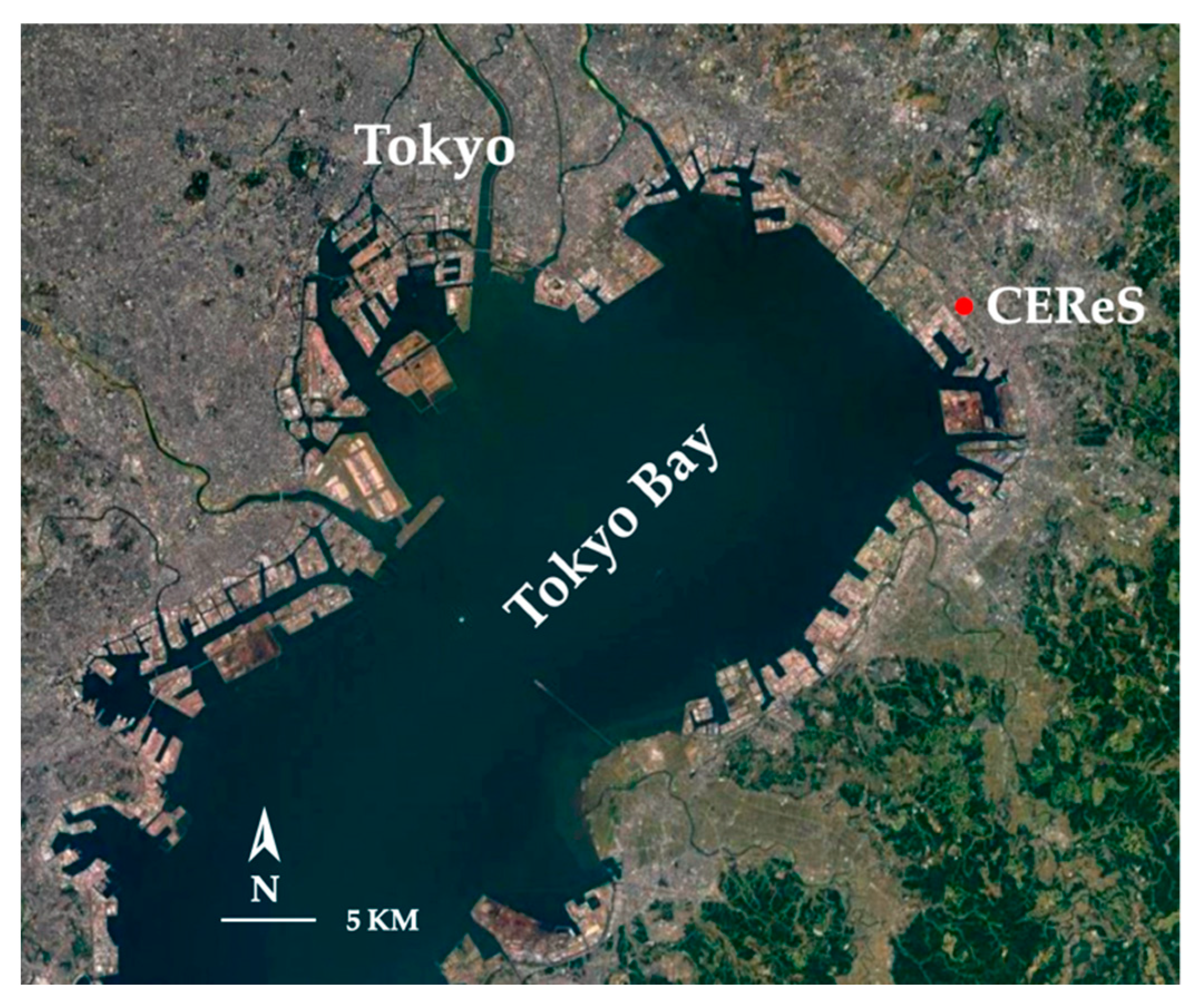
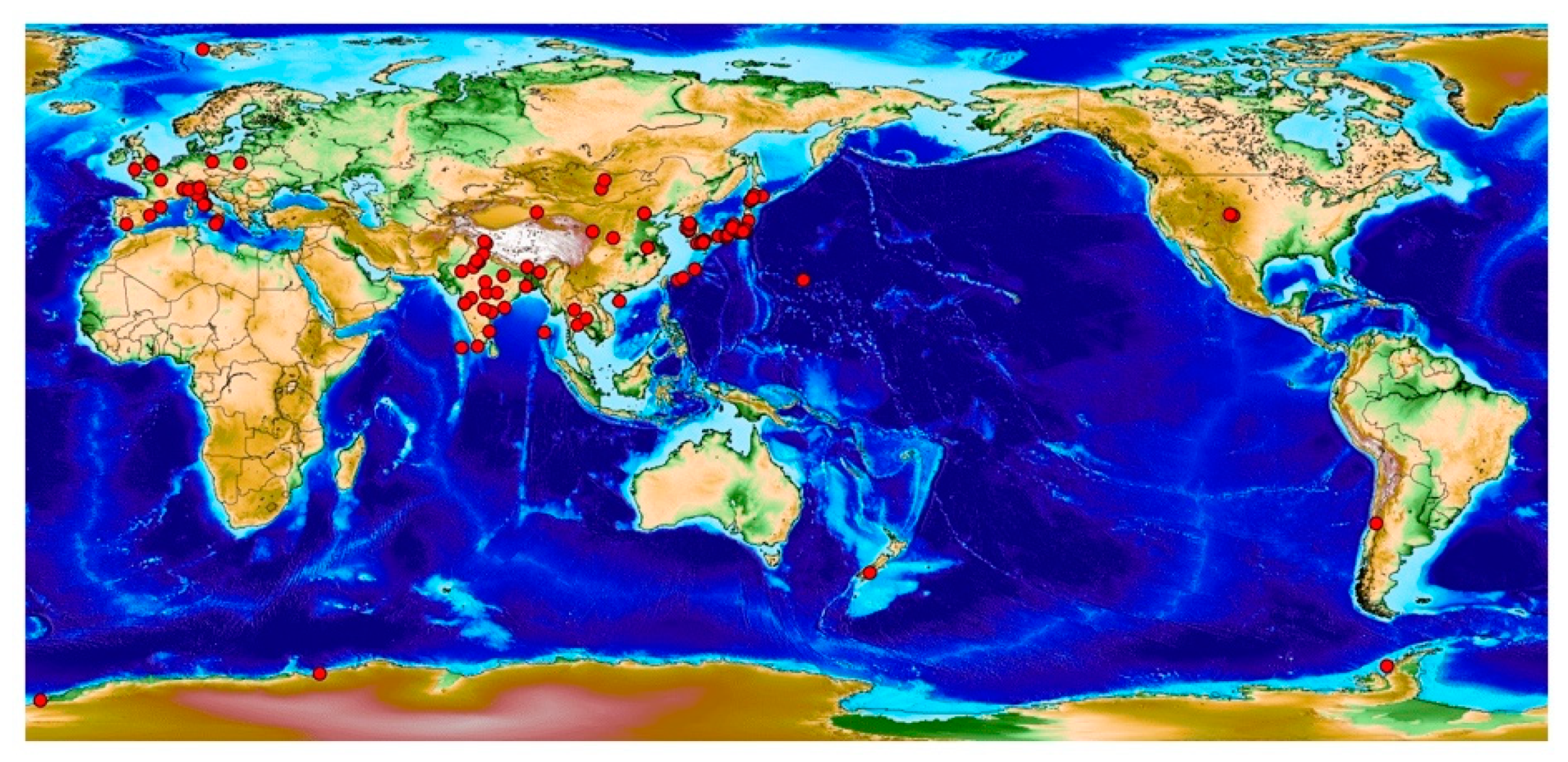
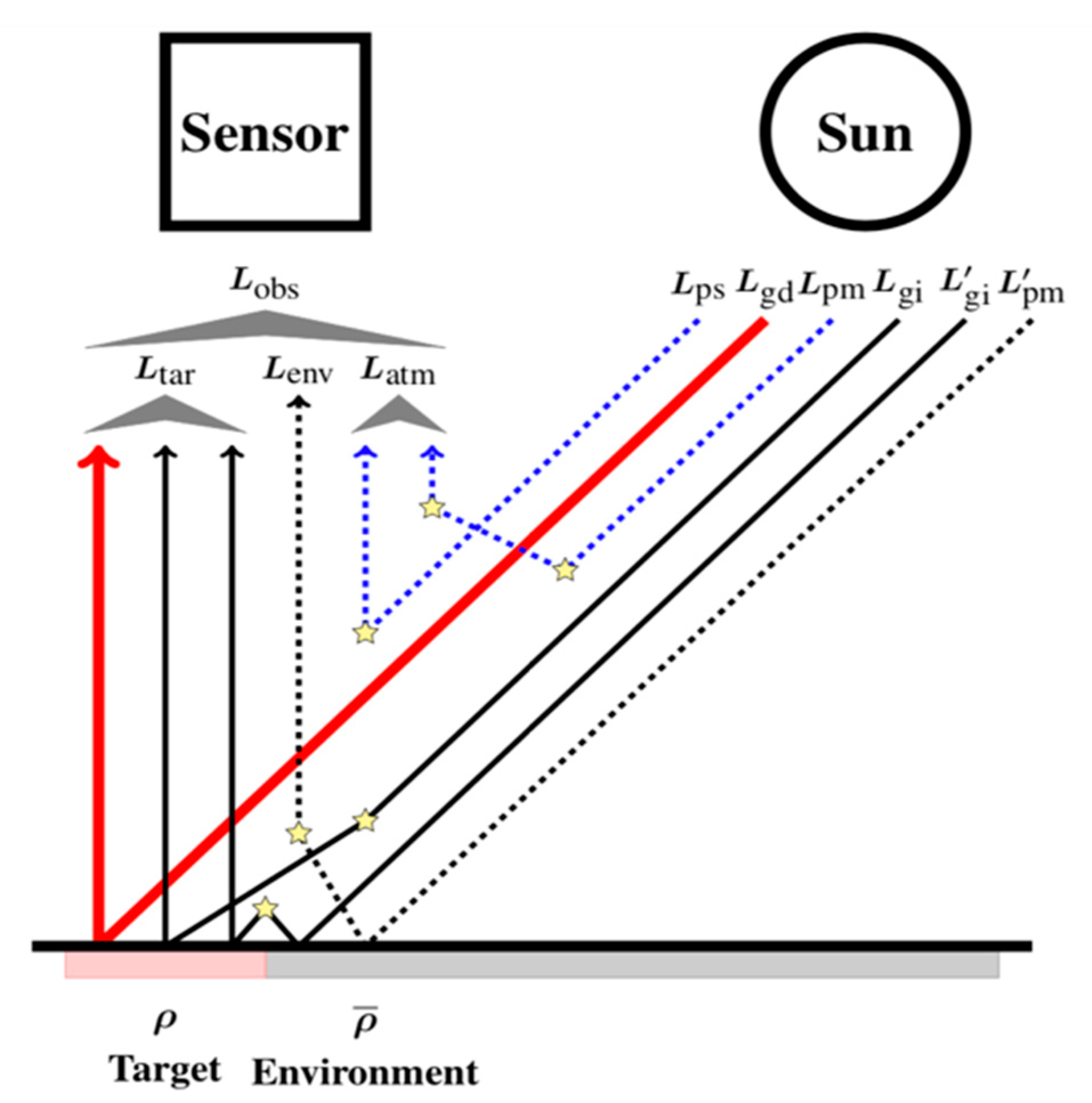

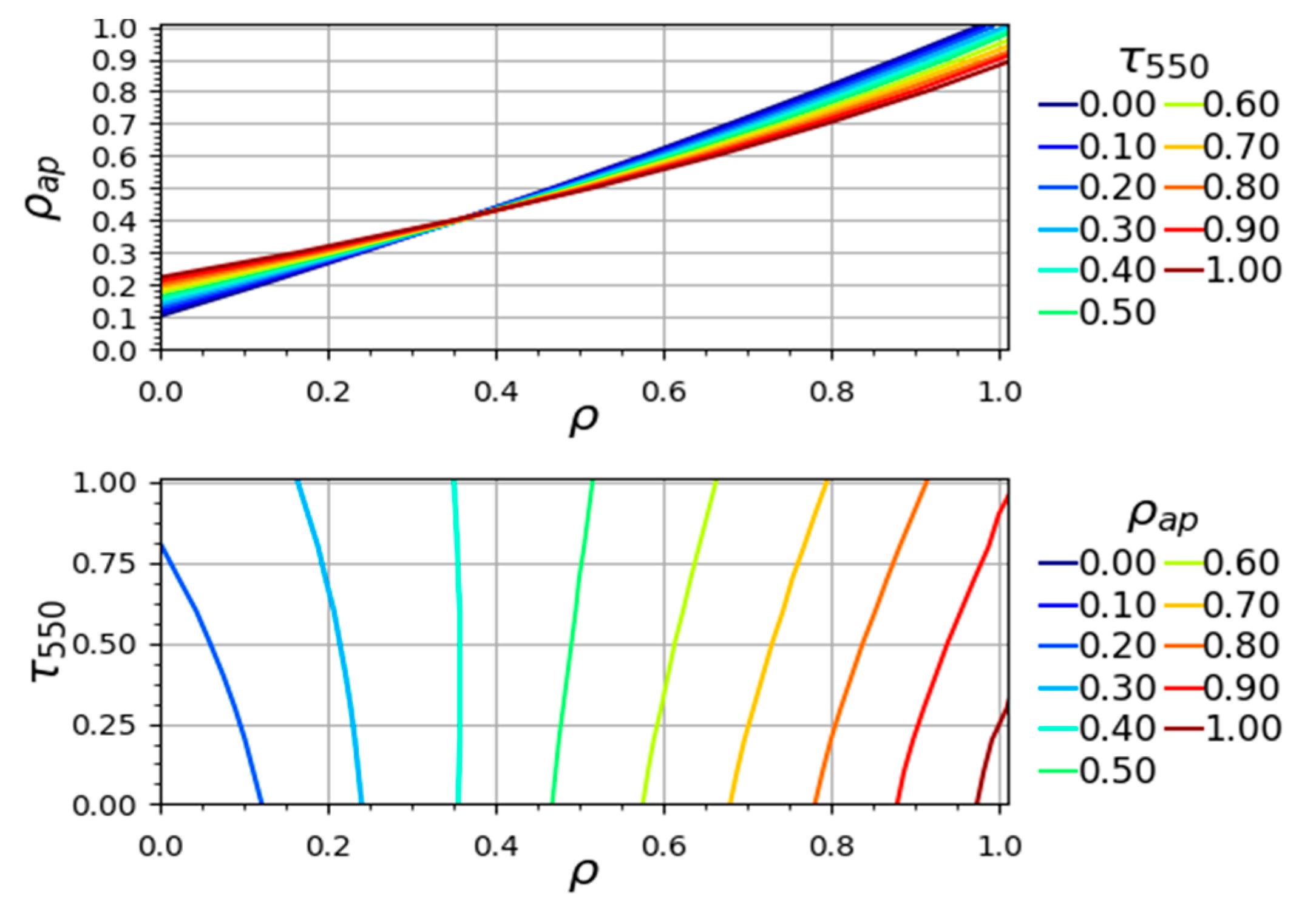


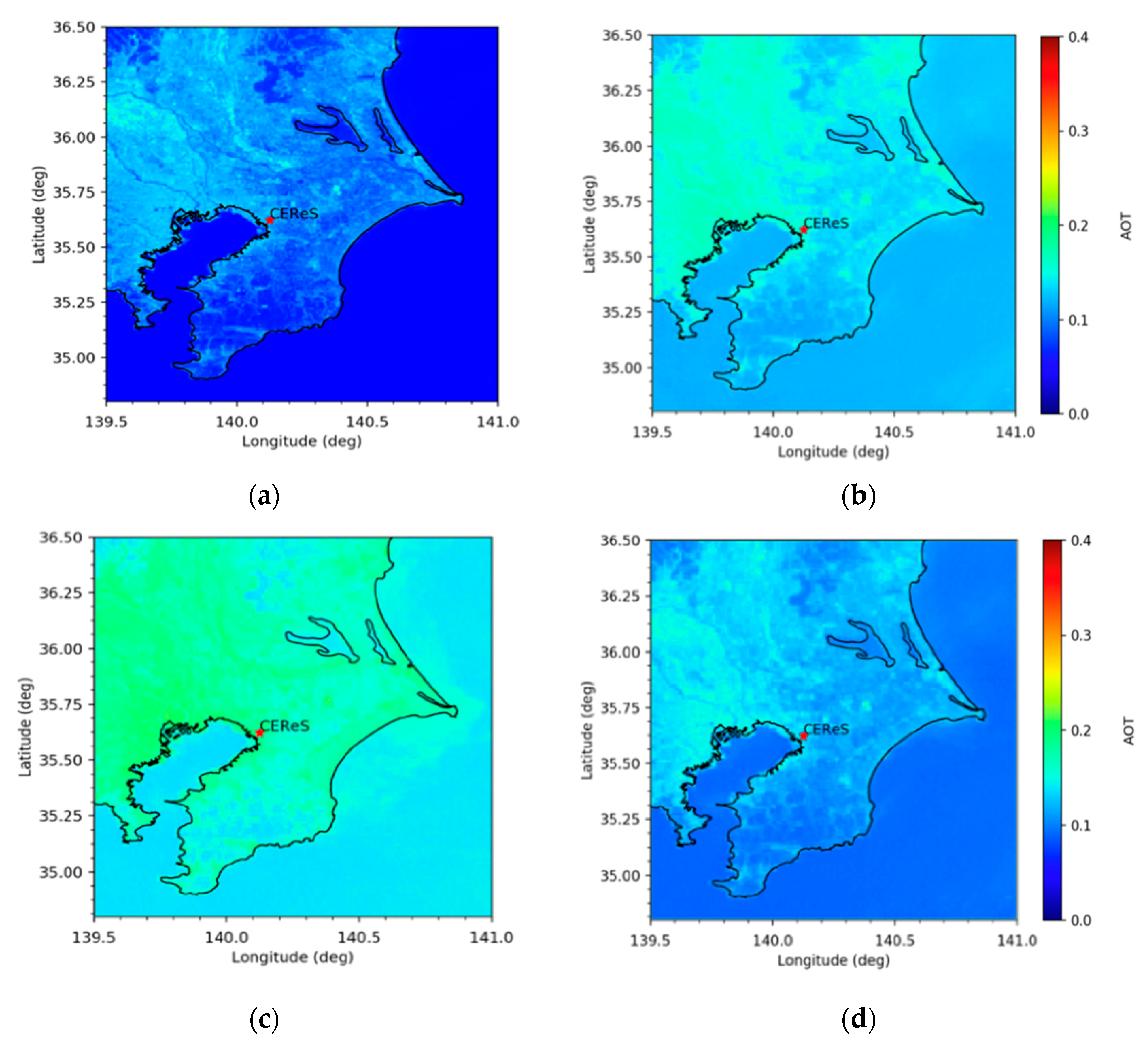

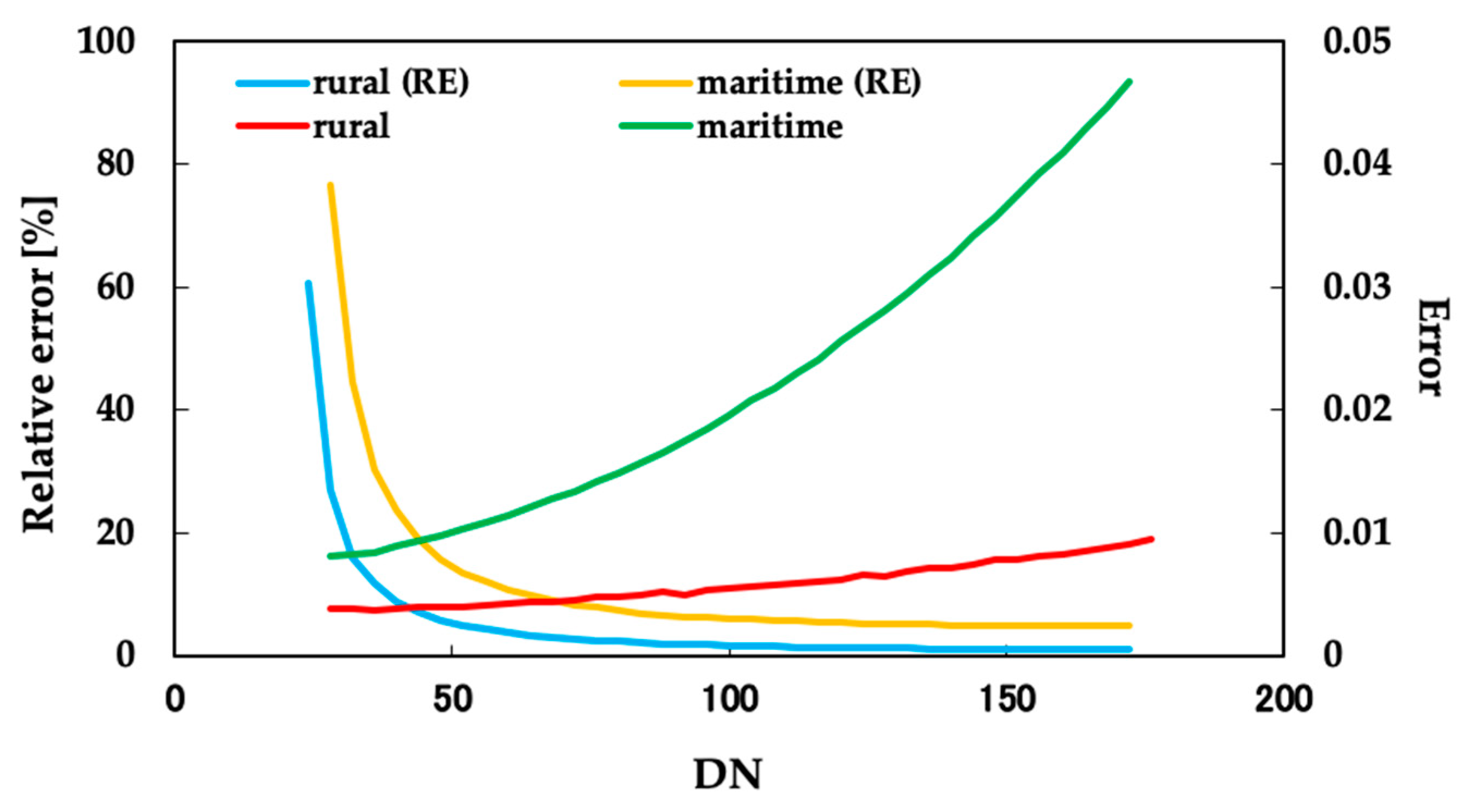
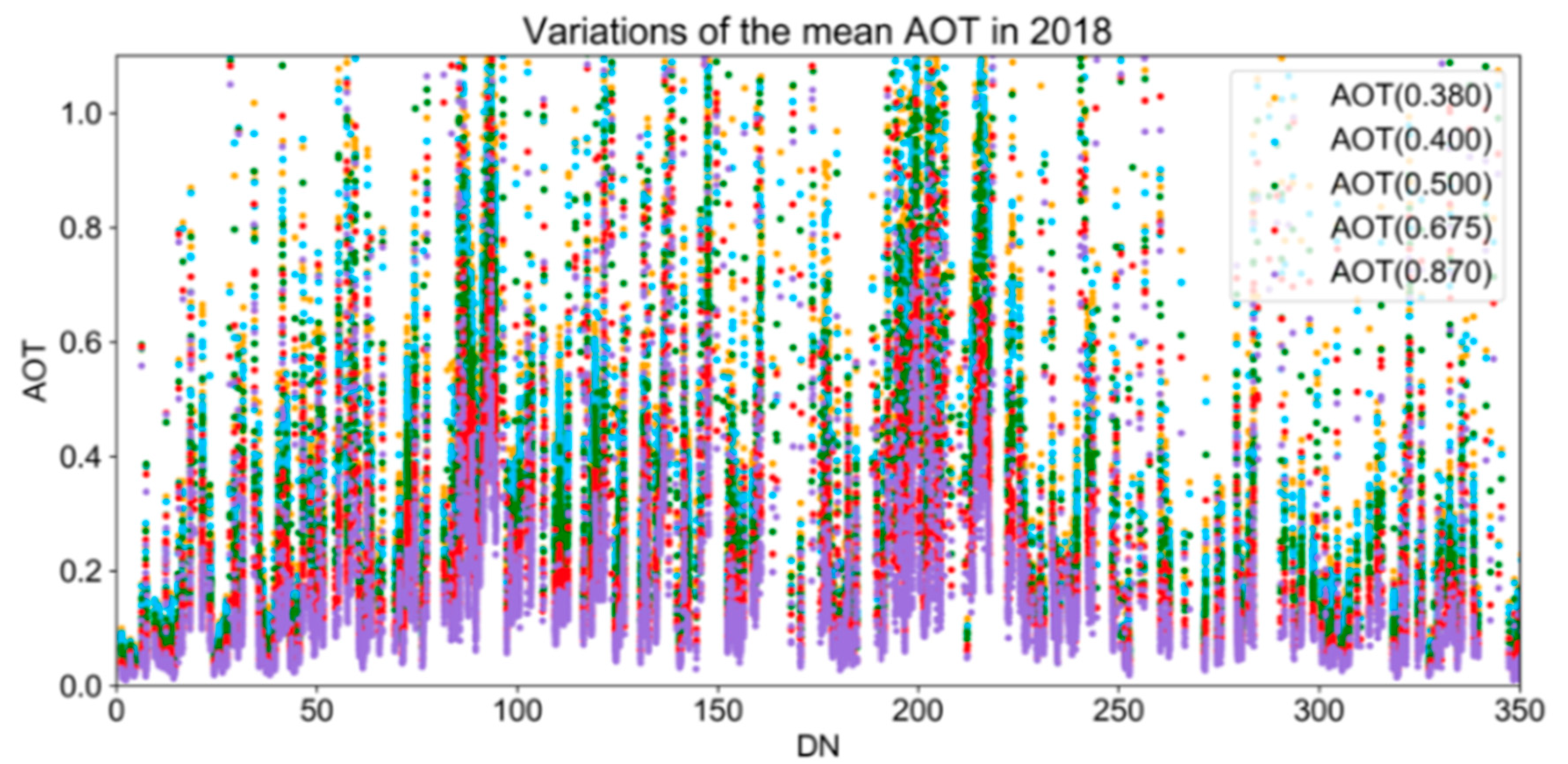
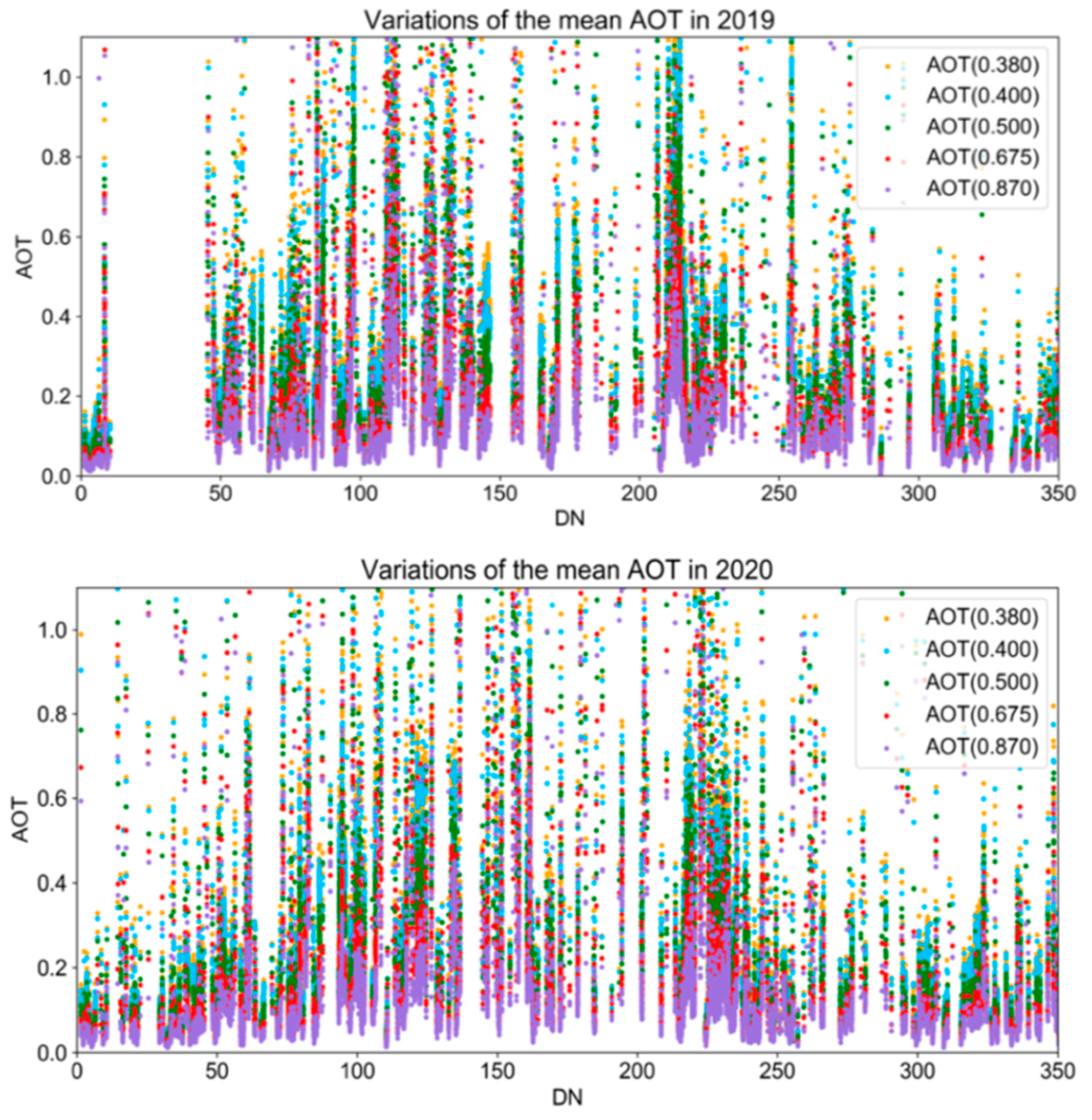



| Date | Solar Azimuth/° | Solar Elevation/° | Solar Zenith/° |
|---|---|---|---|
| 6 January 2020 | 159.80 | 29.01 | 0.485 |
| 4 April 2020 | 146.06 | 55.63 | 0.825 |
| 2 July 2020 | 122.86 | 69.37 | 0.936 |
| 2 October 2020 | 157.11 | 48.16 | 0.745 |
| 4 January 2019 | 160.06 | 28.89 | 0.483 |
| 6 April 2019 | 145.81 | 56.09 | 0.830 |
| 31 July 2019 | 130.30 | 65.66 | 0.911 |
| 9 October 2019 | 158.84 | 46.02 | 0.719 |
| 2 January 2018 | 160.32 | 28.78 | 0.482 |
| 20 April 2018 | 142.54 | 61.04 | 0.875 |
| 4 July 2018 | 122.99 | 69.25 | 0.935 |
| 28 October 2018 | 162.61 | 39.58 | 0.637 |
| Variables | Input Parameters |
|---|---|
| Solar zenith angle | From 0 to 72, step 6 |
| View zenith angle | From 0 to 72, step 6 |
| Relative azimuth angle | From 0 to 180, step 12 |
| Atmospheric model | Mid-latitude winter/summer |
| Aerosol Type | Custom, Rural, Maritime, Urban |
| Aerosol Optical Thickness (AOT@550 nm) | From 0 to 1, step 0.1 |
| Spectral condition | SRF of Himawari-8 visible bands |
Publisher’s Note: MDPI stays neutral with regard to jurisdictional claims in published maps and institutional affiliations. |
© 2021 by the authors. Licensee MDPI, Basel, Switzerland. This article is an open access article distributed under the terms and conditions of the Creative Commons Attribution (CC BY) license (https://creativecommons.org/licenses/by/4.0/).
Share and Cite
Xue, Z.; Kuze, H.; Irie, H. Retrieval of Aerosol Optical Thickness with Custom Aerosol Model Using SKYNET Data over the Chiba Area. Atmosphere 2021, 12, 1144. https://doi.org/10.3390/atmos12091144
Xue Z, Kuze H, Irie H. Retrieval of Aerosol Optical Thickness with Custom Aerosol Model Using SKYNET Data over the Chiba Area. Atmosphere. 2021; 12(9):1144. https://doi.org/10.3390/atmos12091144
Chicago/Turabian StyleXue, Zixuan, Hiroaki Kuze, and Hitoshi Irie. 2021. "Retrieval of Aerosol Optical Thickness with Custom Aerosol Model Using SKYNET Data over the Chiba Area" Atmosphere 12, no. 9: 1144. https://doi.org/10.3390/atmos12091144





